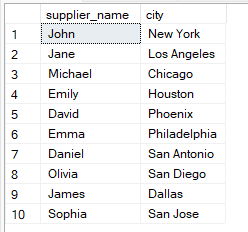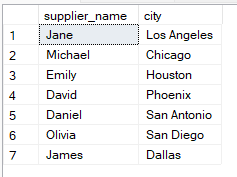Course
The SQL EXISTS() operator checks whether a value or a record is in a subquery. When included in a WHERE() clause, the EXISTS() operator will return the filtered records from the query. Subquery evaluation is important in SQL as it improves query performance and allows the evaluation of complex queries.
If you are an aspiring data analyst or data scientist, I recommend taking DataCamp’s Introduction to SQL course to learn the basics of filtering data in SQL. For a quick refresher on SQL operators and functions, check out our SQL Basics Cheat Sheet.
The Quick Answer: How to Use the SQL EXISTS() Operator
The EXISTS() operator in SQL is used to check for the specified records in a subquery. The EXISTS() operator is typically included in a WHERE clause to filter the records, such as in the example below:
SELECT column_name(s)
FROM table_name
WHERE EXISTS (subquery);Let’s examine the syntax of the above query:
column_name(s): The columns to returntable_name: The table from which you select the data.subquery: The subquery has a nestedSELECTstatement.
Assume you have a Products and Suppliers table, as shown below.

Example of Products table. Image by Author.

Example of Suppliers table. Image by Author.
The following query uses the EXISTS() operator to filter records where the supplier has products and returns the filtered rows.
-- Select all suppliers who have at least one product listed
SELECT supplier_name, city
FROM Suppliers s
WHERE EXISTS (
-- Subquery to check if the supplier has any products
SELECT 1
FROM Products p
WHERE p.supplier_id = s.supplier_id
);The resulting table is given below.

Example output table. Image by Author.
Detailed Examples and Use Cases
At the most basic level, the EXISTS() operator in SQL checks if any rows in a subquery meet the specified condition, as we saw in the example above. But we can also use the EXISTS() operator with more complex conditions. Take a look.
EXISTS() with more complex conditions
The EXISTS() operator can check for multiple conditions from different tables. This technique involves using other operators to check for the specified condition in a subquery. In the query below, the EXISTS() operator checks whether a supplier has products above $5.00. Note that the query includes the AND operator in complex conditions.
-- Select all suppliers who have products priced above $5.00
SELECT supplier_name, city
FROM Suppliers s
WHERE EXISTS (
-- Subquery to check if the supplier has any products priced above $5.00
SELECT 1
FROM Products p
WHERE p.supplier_id = s.supplier_id
AND p.price > 5.00
);
Example output table with complex conditions. Image by Author.
NOT EXISTS() operator
The NOT EXISTS() operator is the opposite of the EXISTS() operator, which is used to find non-matching records in a subquery. For example, the query below filters the data and returns rows from the Suppliers table where the supplier does not have matching products from the Products table.
-- Select all suppliers who do not have any products listed
SELECT supplier_name, city
FROM Suppliers s
WHERE NOT EXISTS (
-- Subquery to check if the supplier does not have any products
SELECT 1
FROM Products p
WHERE p.supplier_id = s.supplier_id
);Advanced Techniques of the SQL EXISTS() Operator
You can also find advanced ways to use the EXISTS() operator, which include the following methods:
EXISTS() with correlated subqueries
The EXISTS() operator evaluates records row by row in correlated subqueries. The query below uses EXISTS() and correlated subqueries to filter records to find products with suppliers located in the same city.
-- Select all products where the supplier is located in the same city as the product's supplier
SELECT product_name, price
FROM Products p1
WHERE EXISTS (
-- Correlated subquery to check if there is another product with the same supplier's city
SELECT 1
FROM Suppliers s1
WHERE s1.supplier_id = p1.supplier_id
AND EXISTS (
-- Nested correlated subquery to ensure the city matches
SELECT 1
FROM Suppliers s2
WHERE s2.city = s1.city
AND s2.supplier_id <> s1.supplier_id
)
);Combining EXISTS() with other operators
The EXISTS() operator is an advanced query technique that can be combined with other operators such as IN, ANY, and ALL for complex filtering. The query below uses this method to find suppliers whose products are priced lower than John’s.
-- Select suppliers who have products priced lower than any product supplied by 'John'
SELECT supplier_name, city
FROM Suppliers s
WHERE EXISTS (
-- Subquery to find products priced lower than any product by 'John'
SELECT 1
FROM Products p1
WHERE p1.supplier_id = s.supplier_id
AND p1.price < ANY (
-- Subquery to get the prices of products supplied by 'John'
SELECT p2.price
FROM Products p2
JOIN Suppliers s2 ON p2.supplier_id = s2.supplier_id
WHERE s2.supplier_name = 'John'
)
);
Example output using EXISTS() with other operators. Image by Author.
Optimizing EXISTS() for performance
The different techniques to optimize the EXISTS() operator for performance include:
Indexing
Indexing the relevant columns speeds up query execution, improving performance.
-- Create index on supplier_id in Products table
CREATE INDEX idx_supplier_id ON Products(supplier_id);
-- Create index on city in Suppliers table
CREATE INDEX idx_city ON Suppliers(city);Use of SELECT 1
The SELECT 1 subquery in the EXISTS() operator improves query readability and performance.
-- Example using SELECT 1 in subquery
SELECT supplier_name, city
FROM Suppliers s
WHERE EXISTS (
SELECT 1
FROM Products p
WHERE p.supplier_id = s.supplier_id
);Limit subquery execution
One method of optimizing the EXISTS() operator's performance is to limit the number of rows a query returns. The query below limits the number of records by fetching rows where the product price exceeds $5.00.
-- Optimized subquery to minimize data retrieval
SELECT supplier_name, city
FROM Suppliers s
WHERE EXISTS (
SELECT 1
FROM Products p
WHERE p.supplier_id = s.supplier_id
-- Limit records to retrieve where price > $5.00
AND p.price > 5.00
);Practical Applications of SQL EXISTS() Operator
There are different applications of the EXISTS() operator in data analysis, which include:
- Data Validation: The
EXISTS()operator in SQL checks for the presence of related data before performing further operations. - Filtering Results: The
EXISTS()operator filters results based on subqueries to return the required records. - Ensuring Data Integrity: The
EXISTS()operator checks whether a particular record is present in a dataset/table before inserting or updating it. - Conditional Updates: The
EXISTS()operator can be used to update records in a table based on the existence of other records. - Deleting Records: The
EXISTS()operator can check and delete records in a table. - Subquery Optimization: When included in correlated subqueries, the
EXISTS()operator in SQL is used for subquery optimization.
I recommend taking DataCamp’s Associate Data Analyst in SQL and Reporting in SQL courses to learn more about practical applications of SQL through data analysis.
Database-Specific Implementations and Considerations
When using the EXISTS() operator, it is important to note its support and query syntax across different databases.
Differences in SQL dialects.
The EXISTS() operator is uniform across MySQL, PostgreSQL, Oracle, and SQL Server databases. So, if you migrate code from one database to another, you wouldn't have to modify this part of the code.
Note that the EXISTS() operator in SQL Server is referred to as Transact-SQL (T-SQL). T-SQL is a query language with advanced features mainly used in the SQL Server database. However, the EXISTS() operator syntax remains similar to the examples shown in this tutorial.
Alternative functions for EXISTS() operator
If you are looking for alternatives, the following functions will help filter data in a way that is similar to the EXISTS() operator.
IN operator
The IN operator checks for record existence just like the EXISTS() operator. However, the IN operator has performance issues since it queries the whole dataset at a time.
-- Using IN to check if suppliers have products
SELECT supplier_name, city
FROM Suppliers
WHERE supplier_id IN (
SELECT supplier_id
FROM Products
);JOIN clause
The JOIN clause is effective for checking the existence of records in related data but less efficient than the EXISTS() operator. The EXISTS() operator is more efficient because it simply checks if a subquery returns any rows without merging the datasets, as JOIN will do.
-- Using JOIN to check if suppliers have products
SELECT s.supplier_name, s.city
FROM Suppliers s
JOIN Products p ON s.supplier_id = p.supplier_id
GROUP BY s.supplier_name, s.city;To learn more about table joins, check out DataCamp’s Learn SQL course, which covers the topic in detail.
Performance Considerations and Best Practices
In some instances, using the EXISTS() operator may cause performance issues. To optimize performance, consider the following practices.
Impact on query performance and strategies to optimize usage
SQL queries using the EXISTS() operator might have performance issues when using large datasets or results in the subqueries. Therefore, applying different filters in the subquery is important to minimize the number of records to fetch. The most effective method is using the SELECT 1 statement to minimize the data processed during filtering.
-- Efficient subquery with selective filtering
SELECT supplier_name, city
FROM Suppliers s
WHERE EXISTS (
SELECT 1
FROM Products p
WHERE p.supplier_id = s.supplier_id
AND p.price > 5.00
);Indexing considerations to ensure efficient subquery evaluation
To improve the subquery performance, index the frequently used column in the WHERE clause. The best technique is creating indexes on columns involved in join conditions and filters in the subquery.
-- Create an index on the supplier_id column in the Products table
CREATE INDEX idx_supplier_id ON Products(supplier_id);
-- Create an index on the supplier_id column in the Suppliers table
CREATE INDEX idx_supplier_id_suppliers ON Suppliers(supplier_id);Monitoring and resolving performance bottlenecks
To monitor performance bottlenecks, use execution plans to identify large nested loops that hinder query execution. Database management tools such as EXPLAIN in SQL Server and MySQL can help understand the execution plan before optimizing the query.
-- Using EXPLAIN to analyze the execution plan
EXPLAIN
SELECT supplier_name, city
FROM Suppliers s
WHERE EXISTS (
SELECT 1
FROM Products p
WHERE p.supplier_id = s.supplier_id
);Utilizing batch processing and query refactoring also helps to break large queries into smaller chunks for faster processing. Batch processing allows large datasets to be filtered in batches, improving execution time.
-- Refactoring a complex query into simpler parts
WITH SupplierProducts AS (
SELECT supplier_id
FROM Products
WHERE price > 5.00
)
SELECT supplier_name, city
FROM Suppliers s
WHERE EXISTS (
SELECT 1
FROM SupplierProducts sp
WHERE sp.supplier_id = s.supplier_id
);The built-in query profiling tools also help to monitor and resolve performance bottlenecks. These tools include:
Conclusion and Further Learning
As we have seen, the SQL EXISTS() operator is useful for checking the existence of records/values in a subquery. Learning to use EXISTS() is important in database management and analysis.
I encourage you to practice the different use cases of EXISTS() with different datasets to master its uses and understand its nuances. If you want to advance your SQL skills, I recommend taking DataCamp’s SQL Fundamentals and Intermediate SQL courses. You should also obtain our SQL Associate Certification to showcase your practical application of SQL which is sure to make you stand out during job interviews.
Frequently Asked Questions
What is the SQL EXISTS operator?
The EXISTS() operator in SQL is used to check for the existence of a record or value in a subquery.
What is the SQL NOT EXISTS operator?
The SQL NOT EXISTS() operator filters records in a table and returns the rows that do not meet the specified condition in the subquery.
Can I use the SQL EXISTS operator to check for multiple conditions?
The EXISTS() operator in SQL can check for multiple conditions when combined with other operators such as AND.
Is the SQL EXISTS operator supported in all databases?
All the major databases, including MySQL, SQL Server, PostgreSQL, and Oracle, support the EXISTS() operator.
What function/clauses are alternatives for the SQL EXISTS operator?
The IN operator and JOIN clause are appropriate alternatives for the EXISTS() operator. However, these alternatives may have performance issues with the query.
Can EXISTS() be used in combination with clauses other than WHERE?
Yes, EXISTS() can also be used with the HAVING clause.
